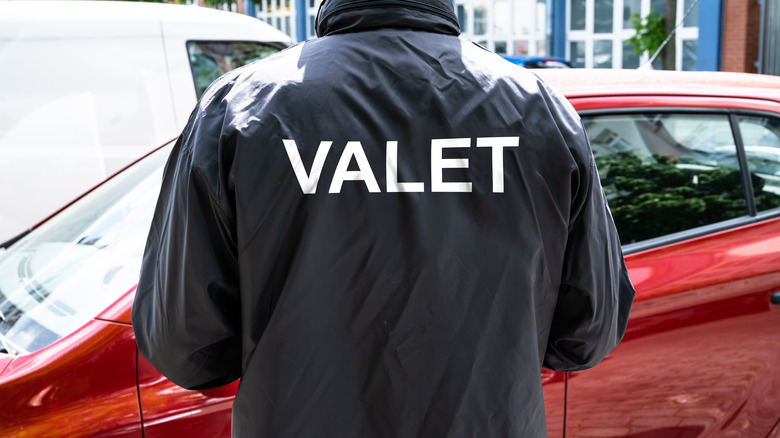What Is Valet Mode On Your Car And When Should You Use It?
When we hear the word valet, many things come to mind: pricey restaurants, exclusive hotels, or perhaps just the convenience of having someone else park your car for you. When you park your car yourself, whether in your driveway or a parking lot, you take certain precautions — rolling up the windows and locking the doors, among other things — all in hopes that when you return, your car will be just as you left it. However, precautions often go out the window when it comes time to hand our car keys over to a valet.
While some of the risks that come with using valet parking are unavoidable, such as dents and dings if you're unlucky enough to have a careless valet, other risks, such as unauthorized access to your car's trunk or the personal information on your vehicle's touchscreen, can be prevented by using your car's valet mode. Valet mode might bring to mind something like BMW's remote parking cars, but it's actually a security feature that, when engaged, limits some of your car's functionalities. That way, you can hand over your keys to the valet, knowing they'll have just enough access to do their job without compromising your privacy or your vehicle's security.
What is valet mode on your car?
Valet mode is another of those features you might not know your car has, but once you start using it, you may wonder how you ever left your car with a stranger without it. While valet mode differs from one car manufacturer to the next, many features are standard across vehicles. One of the most important things your car's valet mode does is limit how fast your vehicle can be driven — which should lessen the chances your valet will be tempted to live out their "Fast & Furious" dreams in your car. It also disables performance modes like autopilot in Telsa and sport mode in other vehicles.
If you're like many people, you store personal items in your glove box and trunk. When valet mode is activated, these compartments are locked, keeping these items secure. Valet mode also turns off your vehicle's infotainment and navigation features, which means the person parking your car won't be able to access personal information like your home or work locations. You can activate valet mode by using your car's key fob or smartphone app, entering a PIN, or flipping the valet switch inside your vehicle, depending on the make and model of your car.
When should you use valet mode?
It's a good idea to turn on your car's valet mode whenever you leave it with a stranger. High-end hotels, restaurants, and even shopping malls often offer valet parking as a convenience for guests; however, giving someone the keys to your car always entails a certain level of risk, no matter how exclusive the location. Valet mode seeks to minimize that risk and give you some peace of mind while you're away from your vehicle.
While valet mode was designed with security in mind, it can also come in handy in situations where you trust the person you're turning your car over to, like a mechanic. When you take your vehicle in to be repaired, turning on valet mode can prevent false alarms while the mechanic works on your car. Valet mode deactivates your car's alarm system so it won't go off during maintenance.
At the same time, if someone you don't know is working on your car — for example, if you take your car into a national auto service chain or a mechanic you've never worked with before — activating valet mode will prevent them from changing your system settings or accessing your personal information while your vehicle is being serviced.


